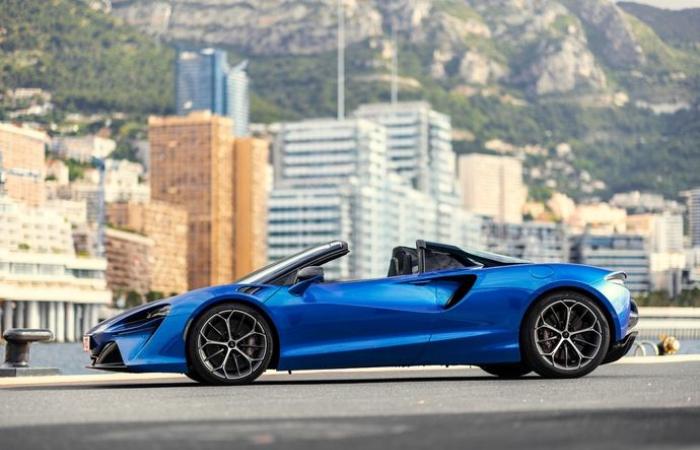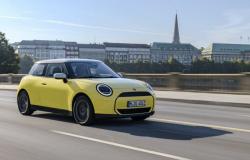IN SHORT
700 ch super sport
No ecological penalty
271 700€
0 to 200 km/h in 8.4s.
1,457 kg dry
The only automobile brand of this level to resist SUVs, McLaren only makes exceptional sports cars and nothing else. His goal since 2011? Compete with Ferrari, Lamborghini, Porsche or Aston Martin with machines all designed around an architecture combining an ultra-light carbon fiber chassis (instead of the often aluminum or steel structures of its rivals), a powerful engine installed in a central position rear and a design philosophy focused on absolute steering precision.
Presented in 2021, the Artura Coupé still responds to this philosophy but by adding a plug-in hybrid engineideal for reducing the CO2 emissions declared on the technical sheet at a time when car manufacturers are being asked by European regulatory authorities to electrify as much as possible.
In addition to a new evolution of the carbon monocoque designed to accommodate an electric motor (an axial flow generator located at the crankshaft outlet), it replaces the V8 equipping all McLarens since the MP4-12C with a unprecedented 3.0-liter twin-turbo V6. and remains light: despite the 7.4 kWh of batteries and the presence of the additional motor (i.e. 130 kg for the entire electrical part), it claims a dry mass of 1,395 kg which remains extremely low for this type of sports car (a 100% thermal Lamborghini Huracan Evo, for example, claims a dry mass of 1,422 kg and a Ferrari 296 GTB, a plug-in hybrid like the McLaren, claims 1,470 kg).
Disturbed by development issues (software and mechanical) which have delayed its marketing and complicated its launch, this Artura is now taking advantage of the arrival of its Spider variant to improve a little : its hybrid bi-turbo V6 sees its maximum power increase from 680 to 700 horsepower (the torque does not change), with a modified mapping to improve engine response. Its “hair in the wind” version, equipped with an electrically retractable hard roof like all McLaren convertibles since the MP4-12C, has a dry mass of only 1,457 kg dry or 62 kg more than the coupe. Here again, it is the carbon fiber monocoque that allows not to increase the mass despite the decapitation (the extra kilos correspond mainly to the roof opening mechanism).
Subscribe to the Caradisiac newsletter
Receive all the latest automotive news
I agree to receive partner offers
Register
The email address provided in this form is processed by GROUPE LA CENTRALE as data controller.
This data is used to send you information about our offers, news and events (newsletters, alerts, invitations and other publications).
If you have accepted it, this data will be transmitted to our partners, as data controllers, to allow you to receive their communication electronically.
You have the right to access, rectify and erase this data, the right to limit processing, the right to object, the right to the portability of your data and the right to lodge a complaint with a supervisory authority (in France, the CNIL). You can also withdraw your consent to the processing of your data at any time. To find out more about the processing of your data: www.caradisiac.com/general/confidentialite/
The McLaren Artura Spider practices extreme sports and tax optimization – Video test
A “classic” McLaren supercar look
Aesthetically, the Artura Spider brings no surprises since it simply uses the same formula as the 750S Spider and the old 570S Spider. But I find that the “spider” type always adds a little theatricality to the lines of the McLarens. Less spectacular than the 750S or the brand’s ultra-limited series supercars (let’s remember in passing that the 2013 P1 remains the first hybrid in McLaren’s history), it does not seem as impressive in design as a Lamborghini Huracan or a Ferrari 296 GTB. All things considered, the simple sight of an Artura in traffic is enough to remind us of the extent to which these cars stand out from the daily routine. Especially when opening the wing door…
A radical but liveable interior
Because of the carbon fiber monocoque, you still don’t get into a McLaren as easily as you do in an Audi R8 (or a much less radically designed Aston Martin Vantage). Compared to the first models of the brand’s modern era, the Artura however benefits from thinner pontoons on the sides of the cell and therefore easier accesseven if you always have to show a minimum of flexibility to slip behind the wheel. After all, this moment of settling in on board is also one of the highlights with these exceptional berlinettas!
Typically McLaren, the interior offers a perfect driving position at ground level. Quite minimalist, the dashboard displays an 8-inch touchscreen tablet in landscape format, operating with an operating system designed in-house. Compatible with Apple Carplay and Android Auto, it displays very decent speed if not perfectly intuitive to use. Without trying to match the luxury of Bentleys and Rolls-Royces, the quality of finish is also at a high level. And if you don’t like the black / Alcantara of our test model, leather configurations in warmer colors exist in the catalog. And the trunk, by the way? 160 liters under the front hood, where a small Mazda MX-5 makes do with 130 liters. Almost a family SUV…






